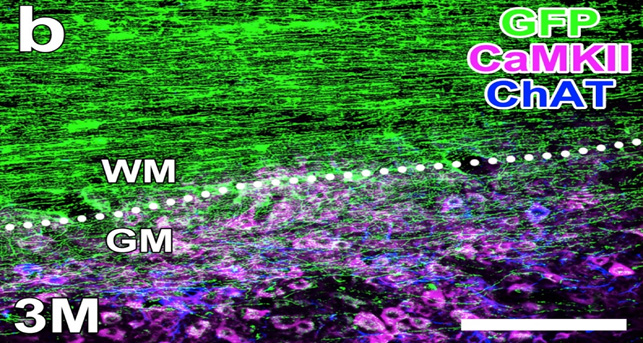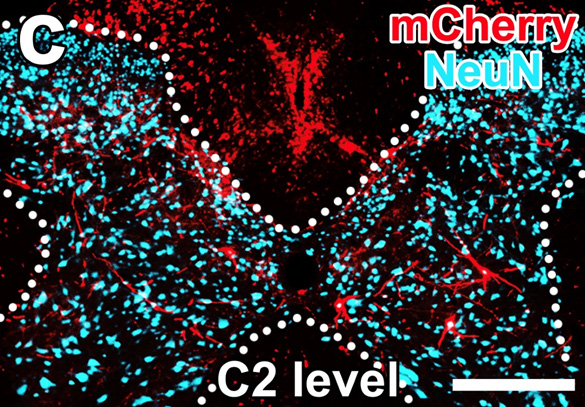In the past month, researchers at the University of California and Veterans Administration San Diego Healthcare System, with partial funding by the Veterans Administration (VA), demonstrated an important step toward producing components for a promising new technology that could help Veterans paralyzed by blast injuries regain some motion.1 In animal models, this therapy shows physical repair, and some functional repair, of substantial damage to the corticospinal tract (CST), the column of neurons within the spinal cord that is the most important among spinal tracts for voluntary movement.
The work builds on a remarkable collaborative study2 from two years ago including the same group of researchers, in which it was demonstrated that cells delivered to lesions in rat CSTs could re-establish connections between the brain and the motor neurons that control muscles, as shown both by microscopic and biochemical examination, and by the recovery of motor control in the partially paralyzed rats. This exciting result presented two formidable barriers to its exploration as a clinical tool for injured Soldiers (and others): firstly, that the considerable biochemical differences between humans and rats might make the same technique unworkable, and secondly, that the cells used had to be specialized "neural progenitor cells" that had developed at least partially into spinal-cord-like cells biochemically similar to those in the lesion. Such cells must be obtained from tissue in complex processes and can't be maintained in a graft-ready state for extended times, or scaled up to produce more material, readily available to the clinic on demand.
The research group showed that the first problem might be tractable this past winter, by modifying the earlier work for use in primates.3 Last month's study addresses the availability and scalability problem by using human stem cells that are "pluripotent," meaning they can develop into a wide variety of tissues. The group tested two types of well-characterized stem cells derived from embryonic tissue and one type made pluripotent from adult cells, and found that by careful control of the biochemical environment in which the cells are grown, they could be developed into precursors of spinal cord tissue, similar to the ones they used previously, and that they maintained that identity while grown, scaled, and maintained for months in the lab. The identity was determined by microscopic examination, biochemical testing, and analysis of gene expression, to show that the created tissue looks similar to the target cell type.
The lab cells were then tested in the rat model. When implanted into a CST lesion, they grew, developed, and made connections back to cells near the brain and forward to motor neurons.
The forward connections were examined microscopically, as new axons – signal transmission routes – were shown to grow from the graft toward the tail, extending into the "grey matter" of the spinal cord, where motor neurons can receive the signal. (Figure 1)

The backward connection was shown by infecting the stem cells with a specially modified and labelled rabies virus, which can travel "upstream" along neural transmission routes; the virus is able to travel from the grafted cells, back into the brain and brainstem. (Figure 2)

Corticospinal cells, which deliver the signal from the brain to the spinal cord, were also seen to grow new axons into the graft, re-establishing the connection, so long as the right cell type is used. Most importantly the graft seems to restore function. The spinal cord injury damages the rats' hind-limb function, as shown in measures of their gait, behavior, and coordination. The graft partially restores that function.
The new work represents a significant milestone on the way to a promising new therapy. Scalable, storable cells can make this kind of treatment clinically available and can serve as a source of tissues for testing other therapies and pharmaceuticals that can offer aid to Service Members who lose motor function on the battlefield.
1 H Kumamaru, K Kadoya, AF Adler, Y Takashima, L Graham, G Coppola, and MH Tuszynski (2018), "Generation and post-injury integration of human spinal cord neural stem cells," Nature Methods 15:723-731.
2 K Kadoya, P Lu, K Nguyen, C Lee-Kubli, H Kumamaru, L Yao, J Knackert,G Poplawski, JN Dulin, H Strobl, Y Takashima, J Biane, J Conner, S Zhang, and MH Tuszynski (2016), "Spinal cord reconstitution with homologous neural grafts enables robust corticospinal regeneration," Nature Medicine 22: 479-487.
3 ES Rosenzweig, JH Brock, P Lu, H Kumamaru, EA Salegio, K Kadoya, JL Weber, JJ Liang, R Moseanko, S Hawbecker, JR Huie, LA Havton, YS Nout-Lomas, AR Ferguson, MS Beattie, JC Bresnahan, and MH Tuszynski (2018), "Restorative effects of human neural stem cell grafts on the primate spinal cord," Nature Medicine 24: 484-490.
Your 15 minute session will timeout in approximately 10 minutes.
If you're in the middle of entering information, please close this warning and save your progress (if possible) or finish up your task.
If your session fully times out, you will lose any un-saved work.
Your current Blast Injury Research Program session has expired.
Your next click will take you away from the private area, and you will lose any work you have in-progress.
Please enter your email address, and try again.